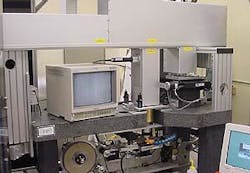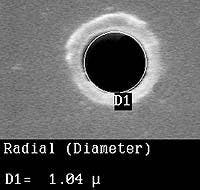Drilling nozzles for pulmonary drug delivery
Excimer lasers for photoablation provide the low-cost, high-volume process techniques to produce accurate, repeatable nozzle plates
Todd Lizotte
Pulmonary drug delivery provides several advantages over injection methods, including fast access to the blood stream, a non-invasive method of delivery (no injections) and the ability to effectively deliver new protein- and peptide-based macromolecules that are not suitable for oral delivery and require lengthy IV or painful injection delivery.
This delivery method is particularly important as a convenient and pain-free alternative to injection delivery of insulin for diabetics or complex pharmaceuticals for multiple sclerosis patients. These patients desire alternatives to injection drug delivery, as most endure multiple self-injections each day. Delivery of therapeutic drugs through the lung provides effective targeting of certain respiratory tract diseases such as emphysema or asthma. This direct delivery most often results in a better treatment outcome, allowing for reduced dosages and superior onset speed compared to systemic delivery, either orally or by injection. Faster drug absorption benefits treatments for pain, spasms, panic/anxiety, hypertensive crisis, anaphylaxis (severe food or insect bite allergies), nausea, cardiovascular conditions (arrhythmia, strokes) and Parkinson's "lock-up" and seizures. Where speed is important, pulmonary drug delivery offers greater options.
Package principlesThe packages currently being developed for fluids are based on single-dose packages incorporating a molded blister containing the appropriate dosage, capped with a sealed fluid channel leading to a nozzle plate. The concept was developed around the idea that the blister pack is quickly loaded into a handheld device that activates a hammer, squeezing the blister reservoir and forcing the capped seal to open so that the drug can proceed down the fluid channel to the nozzle plate. The pressure forces the fluid through the nozzle, atomizing the drug. All of this takes place while a patient is inhaling, and through smart technology the atomization is triggered at the appropriate time. This package type provides the best overall performance as it can be packaged small and ruggedly for distribution (see Figure 1).Nozzle drilling processCreating an aerosol with particle sizes on the order of 1 to 3 microns is not an easy task and requires a fabrication process that can produce accurate and repeatable nozzle plates. Because these are single-use disposable devices, the low-cost, high-volume process techniques are critical. Aerosol particles at this size require the nozzle plates to have exit diameters of less than 1.0 micron.In this age of micro-miniaturization, there are very few micro-forming or micro-machining techniques that can create the required nozzle exit diameters and only one that can achieve an acceptable unit cost. Forming nozzles to these dimensions is only possible with the use of a process called photoablation using excimer laser technology. Photoablation is defined as a mechanism by which the absorption by the material of short, intense energy pulses leads to the complete breaking of the chemical bond in the material followed by the expulsion of the fragmented material. The minimum energy required in a given material to break apart the chemical bonds is termed the ablation threshold. The ejected material carries away any excess energy and, for this reason, the excimer is considered a heatless laser.
Most organic materials exhibit high absorption coefficients when exposed to laser energy at the ultraviolet wavelengths, with absorption occurring on a thin layer at the surface, typically at a depth of less than 1 micron depending on the type of polymer, fluence (energy density) and wavelength being used. These characteristics allow for selective removal of irradiated material and micro-structuring to precise depths, making the excimer laser perfect for creating the holes used for pulmonary drug delivery atomizing nozzles. Figure 2 shows a typical excimer micro-nozzle drilling system.
Nozzle sidewall formationWhen forming an aerosol, the nozzle hole needs to be configured in a manner that facilitates the compression of the fluid. In most cases this requires the nozzle hole to have a sweeping conical or funnel configuration transitioning from the entrance to exit openings. To overcome the inherent difficulties involved in forming these geometries, special optical techniques are employed.The most common method of generating specialized nozzle configurations is through the application of an optical technique called dithering or wobbling. The image is created on a mask and then physically moved in a spiral pattern at the target image plane. Figure 3 shows a variety of methods used by optical designers to achieve these unique shapes. Through the manipulation of the duration of the spiral and the pulse rate of the laser, the sidewall geometry of the nozzles can be altered. By applying well-known algorithms, these sidewall shapes can be modeled mathematically and predictably reproduced using the wobbling/dithering method. Figure 4 shows a typical exit hole.
High-volume manufacturingWhen applying an excimer process for high-volume manufacturing of nozzle plates for medical applications, material-handling automation must be configured for maximum throughput. The use of reel-to-reel or web material handling systems in component manufacturing allows the production process to be as continuous as possible.The use of a continuous web or TAB sprocket material minimizes downtime by allowing nozzle manufacturers the ability to load material for a full production cycle. However, the use of a continuous process requires substantial process automation control, including temperature monitoring, focus control, energy density on target, inline inspection, material thickness monitors and the continuous data acquisition of laser performance. Current-generation equipment incorporates comprehensive alignment and calibration routines minimizing the need for high-level engineers to perform maintenance activities. These routines include automated focus, alignment camera calibration and optical alignment procedures and tools.
FutureThe application of micro-fluidics and micro-machining to pulmonary drug delivery has created significant advances in drug-delivery technology with a potential for providing a convenient and pain-free alternative to injection techniques. Other applications involving recent events with inhaled anthrax might boost the development of the technology, because the direct delivery of antibiotics to the effected lungs would potentially provide an effective therapy, maybe even kill the bacteria before it gets a chance to become active. Only time will tell, but, as it stands, the technology has a bright future.Todd E. Lizotte is chief development officer/vice president of R&D of NanoVia, LP, Londonderry, NH. Contact him at Tel. 603-421-0713, Fax 603-421-0214 or e-mail [email protected].




